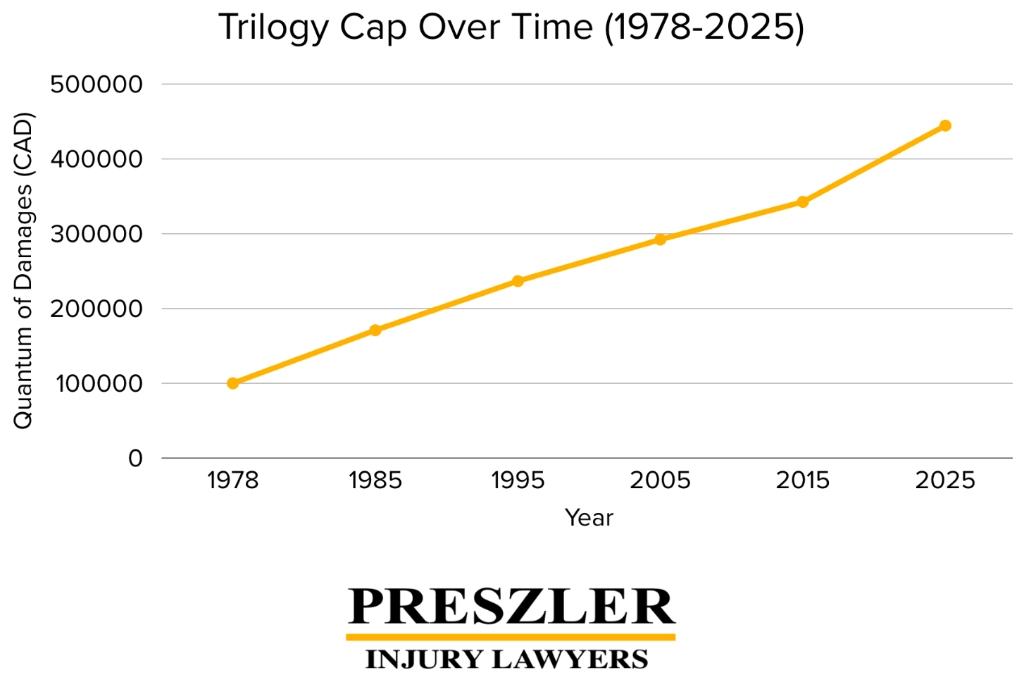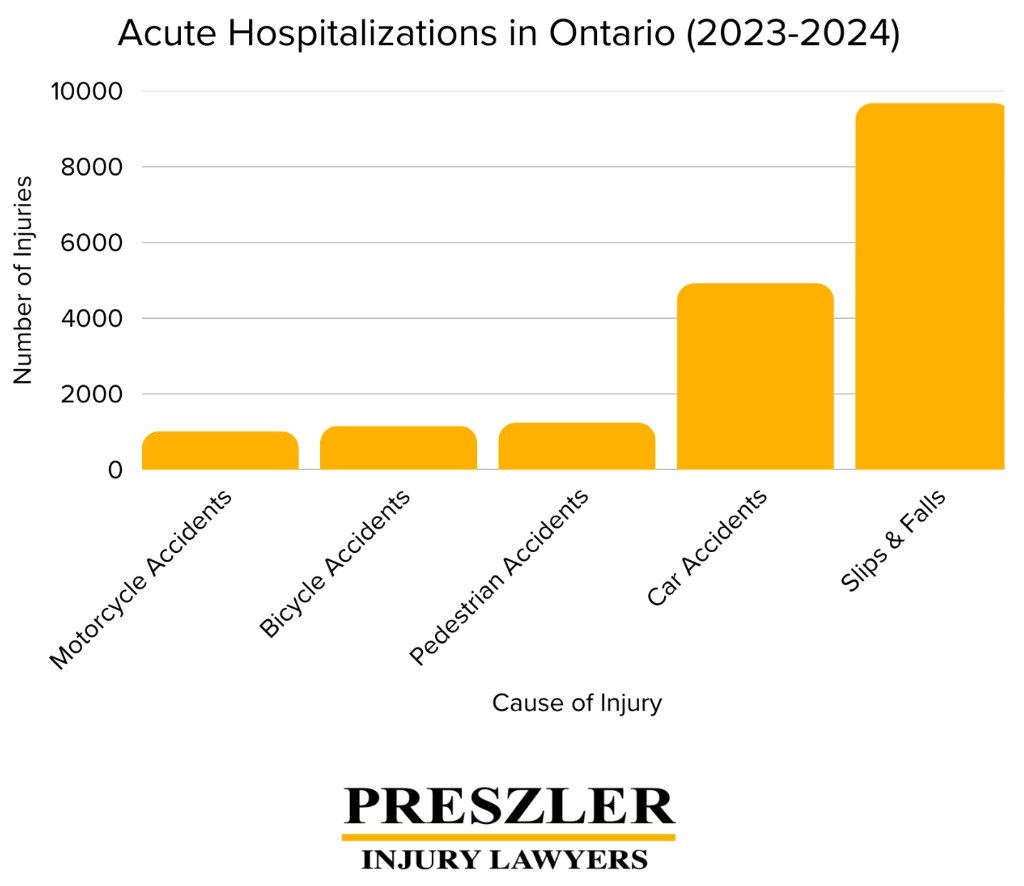November 13, 2025 | personal injury Claims
Pain and Suffering Damages Calculator for Ontario (2025): Thresholds and Deductible Explained
Table of Contents
In Ontario, pain and suffering damages (also known as non-pecuniary or general damages) compensate for human losses that don’t appear on a tangible bill. For example:
- Pain
- Loss of enjoyment of life
- Emotional distress
- Loss of amenities
- Inconvenience
- And other related intangible harms
When you file a lawsuit against a negligent party, the damages you are owed for pain and suffering are assessed on a case-by-case basis, depending on the severity of your losses. It is essential to note that, across Canada, non-pecuniary damages are subject to the Supreme Court’s “Trilogy” cap, which is indexed for inflation and currently sits at approximately $469,000 at its upper limit.
What Counts as “Pain and Suffering” in Ontario?
When deciding how to award non-pecuniary damages in a personal injury lawsuit, courts will consider the human impact of injuries in addition to the financial impact. They will typically analyze:
- Nature & Seriousness of Injury: Courts will consider the extent of persistent pain, physical limitations, as well as the presence of psychological injuries, including anxiety, depression, PTSD, or sleep disturbance. In addition, they will consider whether the injuries sustained were orthopedic or soft-tissue, resulted in chronic pain, traumatic brain injury (TBI), or other serious conditions.
- Functional Impact: Courts will examine whether a loss of amenities occurred, wherein the plaintiff can no longer pursue prior hobbies or roles. In addition, they will consider work endurance, impact on daily activities, loss of dignity or autonomy, mobility, recreational ability, and intimacy. Visible scarring or disfigurement can also contribute to the court’s calculation of non-pecuniary damages.
- Duration and Prognosis: The duration that your injuries will affect you for, also called the prognosis, will be factored into the damages you are eligible for. This assessment may be supported by specialist reports, functional testing, employer evidence, and credible witness testimony.
This approach to the assessment of pain and suffering damages aligns with appellate guidance in Ontario (for example, Lindal v. Lindal). It frames non-pecuniary damages around fairness and reasonableness rather than strict formulas. For this reason, the presentation and assessment of before and after evidence is crucial when demonstrating the intangible losses of a plaintiff.
Factors Courts Weigh When Assessing Pain & Suffering Damages

What is Canada’s “Trilogy” Cap?
In 1978, the Supreme Court of Canada set an upper limit of $100,000 for non-pecuniary damages. This decision was based on a trilogy of landmark cases involving pain and suffering:
As a result, in a tort claim, a plaintiff may not receive more than $100,000 for pain and suffering. This upper limit is indexed each year for inflation. As of 2025, the upper range (for rare, catastrophic losses) sits around $450,000.
Trilogy Cap Over Time (1978-2025)

Special Rules for Ontario Motor Vehicle Accident Claims
When it comes to filing lawsuits after motor vehicle accidents, pain and suffering damages are treated differently than in other personal injury claims. Ontario auto-tort law imposes two additional hurdles that may materially affect pain and suffering outcomes:
The Statutory Threshold (Who Qualifies)
To recover non-pecuniary damages after a motor vehicle accident, the plaintiff must prove death, permanent serious disfigurement, or permanent serious impairment of an important physical, mental, or psychological function under O. Reg. 461/96.
This regulation outlines specific definitions for “permanent,” “serious,” and “important function,” and specifies the medical/functional evidence that is required to prove the severity of the plaintiff’s condition.
The Monetary Threshold & Statutory Deductible
In Ontario motor-vehicle lawsuits, a court can award money for pain and suffering. If that award is below the government-set dollar amount (the deductible threshold), the law stipulates that the judge must subtract a fixed amount from the award first. This fixed amount is called the statutory deductible. Both the threshold and the deductible increase every year with inflation and are set out by the Financial Services Regulatory Authority (FSRA) in Ontario.
As of 2025, thresholds and deductibles for motor vehicle accident claims stand at:
- Non-Pecuniary Damages (pain & suffering) Threshold: $155,965.54
- Non-Pecuniary Damages Deductible if Under the Threshold: $46,790.05
- Family Law Act (FLA) Loss of Guidance/Care/Companionship Threshold: $77,982.13
- FLA Deductible if Under The Threshold: $23,395.04
If the amount of non-pecuniary damages you are awarded for your motor vehicle accident meets or exceeds the threshold, no deductible will apply. This is often referred to as a “vanishing” deductible. Every January 1, FSRA updates the threshold and deductible using the prior year’s inflation figure. In 2025, the increase was set at 1.6%.
The deductible/threshold system for motor vehicle accident claims was introduced to discourage smaller pain-and-suffering lawsuits arising from auto collisions. This way, full non-pecuniary recovery is reserved for more serious injuries. When applied, the statutory deductible generally results in moderate awards being reduced unless they clear the threshold set.
Motor Vehicle Accident Deductible Scenarios (2025)

Why Are Pain & Suffering Damages Important?
In Ontario, each year, accidents resulting in serious injuries to unsuspecting victims are unfortunately common. Between 2023 and 2024, there were 283,000 acute inpatient hospitalizations due to injury in Canada. This is a nearly 10% increase compared to hospitalization figures between 2022 and 2023.
When another party’s negligence results in financial, physical, or emotional losses, you deserve compensation that represents the full extent of the harm you’ve endured. Pain and suffering (non-pecuniary) damages ensure that the intangible losses you have suffered, unrelated to your finances, are compensated appropriately. This allows you to hold negligent parties fully accountable for the pain they’ve caused.
Acute Hospitalizations in Ontario by Accident Cause (2023-2024)

Frequently Asked Questions: Pain & Suffering Damages in Ontario
Is there an average pain & suffering award in Ontario?
No. Pain and suffering damages are awarded on an individual basis. To calculate the amount you are owed, judges may compare your situation to similar cases, weigh medical/functional evidence, and apply the national cap, where necessary.
If you have questions about the amount of damages you may be entitled to, it is recommended that you speak to an experienced personal injury lawyer as soon as possible.
Do non-auto cases have an Ontario tort deductible?
No. The statutory deductible and threshold only apply to tort claims over motor vehicle accidents. All lawsuits stemming from negligence claims, however, are subject to the national Trilogy cap.
Does the Trilogy cap limit income loss or care costs?
No. The cap is only for pain and suffering (non-pecuniary damages). Pecuniary heads of damages, such as income loss, future care, housekeeping costs, and out-of-pocket expenses, are assessed separately and are not capped.
How Preszler Injury Lawyers Can Help You Pursue Pain & Suffering Damages in Ontario
When you decide to pursue a tort claim for your personal injury, the intangible losses you have suffered are just as important as your financial losses. When you’re living with pain, sleep loss, anxiety, or the loss of activities that once defined you, “non-pecuniary damages” aren’t abstract–they’re about dignity and quality of life. At Preszler Injury Lawyers, our team builds these claims on behalf of clients with compassion, commitment, and strategic advocacy.
When you work with our team, we’ll help you obtain pain and suffering damages through:
- Evidence-First Case Building: We will map out your claim early, including your injuries, daily limits, and goals. We’ll line up the effects of your accident with the right proof, such as specialist medical opinions, OT/PT or FCE testing, mental health evaluations, scar documentation, and clear before/after statements from your family, friends and employers. We can then position your non-pecuniary damages within the current Ontario ranges and the Canada-wide cap, where applicable.
- Assessing the Full Extent of Your Damages: Alongside all of the non-pecuniary loss you have incurred, we will calculate the economic heads of damages you are eligible for. This may include your financial losses related to income loss, future care/rehabilitation, housekeeping, out-of-pocket expenses, and more. This way, our negotiations and trial strategy will reflect the full extent of your harm, not just a part.
- Negotiation With Leverage: We assemble medical, functional and vocational evidence, use recent Ontario comparables, and stay ready for litigation no matter what. This helps us move insurers away from generic offers and obtain the compensation you truly deserve.
When it comes to Ontario auto-tort cases, our legal team has decades of combined experience helping clients navigate applicable thresholds and deductibles. We can help you address permanence/seriousness/important function under O. Reg. 461/96 with targeted medical and functional proof. We’ll also model gross vs. net outcomes using up-to-date figures and aim to, where the evidence is available, surpass the threshold so the deductible does not apply. We can also help family members claim damages under the Family Law Act for close relatives who have been affected.
At Preszler Injury Lawyers, we pride ourselves on our consistent, transparent, and results-driven approach to personal injury law. With easy-to-understand updates, clear contingency fees, and province-wide access, we’ll make sure you know your options and help you pursue the maximum amount of compensation available.
Contact Our Personal Injury Lawyers For Assistance With Your Claim Today
If you have been injured in a motor vehicle accident or other incident that has caused you significant financial, physical, and emotional loss, our legal team at Preszler Injury Lawyers is here to help. With years of experience helping clients pursue the pain and suffering damages to which they are entitled, we’ll handle your case with care, compassion, and strategy.
Remember: you don’t pay any money to us unless we successfully obtain compensation on your behalf. Your initial consultation with us is completely free, confidential, and comes with no obligation to work with us in the future.
To discuss your accident and the pain and suffering damages you may be eligible for, call 1-888-608-2111 or fill out our online case evaluation form today.
Source Notes
FSRA — 2025 Automobile Insurance Indexation Amounts. Financial Services Regulatory Authority of Ontario. Official indexation rate and tort thresholds/deductibles effective Jan 1–Dec 31, 2025 (incl. FLA amounts). https://www.fsrao.ca/industry/auto-insurance/regulatory-framework/guidance-auto-insurance/2025-automobile-insurance-indexation-amounts-guidance/
Ontario Regulation 461/96 — Court Proceedings for Automobile Accidents.
Ontario e-Laws consolidated text. https://www.ontario.ca/laws/regulation/960461
Insurance Act, R.S.O. 1990, c. I.8 (Ontario). Statute governing Ontario auto-tort, including s. 267.5 (deductible framework) and FLA interactions. https://www.ontario.ca/laws/statute/90i08
Supreme Court of Canada — Arnold v. Teno (1978). https://decisions.scc-csc.ca/scc-csc/scc-csc/en/item/2589/index.do
Supreme Court of Canada — Thornton v. School Dist. No. 57 (Prince George) et al. (1978). https://decisions.scc-csc.ca/scc-csc/scc-csc/en/item/2607/index.do
Supreme Court of Canada — Andrews v. Grand & Toy Alberta Ltd. (1978). https://decisions.scc-csc.ca/scc-csc/scc-csc/en/item/2587/index.do
Supreme Court of Canada — Lindal v. Lindal (1981). https://decisions.scc-csc.ca/scc-csc/scc-csc/en/item/5631/index.do
CIHI — Injury and trauma: emergency department and hospitalization statistics (2023–24). https://www.cihi.ca/en/injury-and-trauma-emergency-department-and-hospitalization-statistics/
Blog Categories
More personal injury Topics
Here’s more information on personal injury related topics that we think you might find helpful.

personal injury
|
January 23, 2024
Injured as a Worker in Ontario? A WSIB Claim Isn’t Necessarily Your Best— Or Only— Option
In Ontario, the compensation of workers who sustain injuries or illnesses in the course of their employment is governed by the Workplace Safety and Insurance…

personal injury
|
December 7, 2023
Does a Child Have the Right to Sue for Personal Injury?
As much as parents and guardians do everything they can to keep children safe and protected from dangerous situations, there are occasions when a child…

personal injury
|
October 10, 2023
Gain Peace of Mind Through a Structured Settlement
The phrase “structure binds anxiety” is often used by psychologists to help people suffering from anxious feelings and intrusive thoughts. This maxim’s aim is to…
